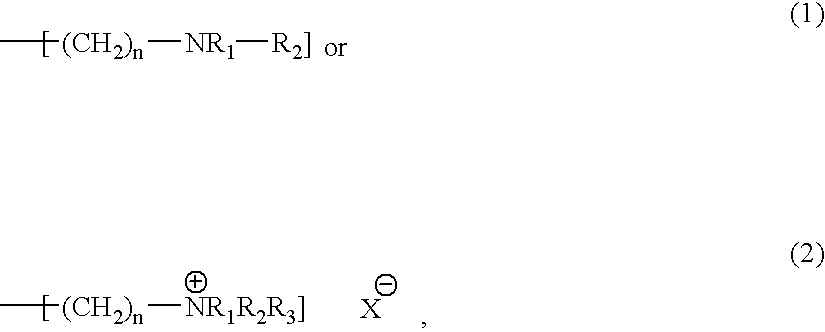Process for preparing monodisperse anion exchangers
a monodisperse anion exchanger and anion exchange technology, applied in the direction of ion exchangers, water/sewage treatment by ion exchange, chemistry apparatus and processes, etc., can solve the problem of insufficient yield of final anion exchanger products in liters per unit of starting material used, inability to achieve further significant increase, and insufficient utilizable capacity of anion exchangers
- Summary
- Abstract
- Description
- Claims
- Application Information
AI Technical Summary
Problems solved by technology
Method used
Image
Examples
example 1
1 a) Preparation of the Monodisperse Macroporous Bead Polymer Based On Styrene, Divinylbenzene, and Ethylstyrene
[0066]3000 g of deionized water were placed in a 10 liter glass reactor, and a solution made from 10 g of gelatin, 16 g of disodium hydrogen phosphate dodecahydrate, and 0.73 g of resorcinol in 320 g of deionized water was added and thoroughly mixed. The temperature of the mixture was controlled to 25° C. Then, with stirring, a mixture made from 3200 g of microencapsulated monomer droplets with a narrow particle size distribution and made from 3.6% by weight of divinylbenzene and 0.9% by weight of ethylstyrene (used in the form of a commercially available isomer mixture of divinylbenzene and ethylstyrene in 80% of divinylbenzene), 0.5% by weight of dibenzoyl peroxide, 56.2% by weight of styrene, and 38.8% by weight of isododecane (industrial isomer mixture with a high proportion of pentamethylheptane), wherein the microcapsules were composed of a formaldehyde-hardened comp...
example 2
[0090]Preparation of a Monodisperse, Moderately Basic Anion Exchanger Having Dimethylaminomethyl Groups and Also Trimethylaminomethyl Groups
[0091]An initial charge of 1220 ml of bead polymer from Example 1d) containing dimethylaminomethyl groups, 1342 ml of deionized water, and 30.8 g of chloromethane at room temperature was heated to 40° C. and stirred at this temperature for 6 hours.
[0092]Yield of resin containing dimethylaminomethyl groups and trimethylaminomethyl groups: 1670 ml.
[0093]The extrapolated overall yield was 2331 ml.
[0094]Of the groups containing nitrogen atoms within the product, 24.8% were trimethylaminomethyl groups and 75.2% were dimethylaminomethyl groups.
[0095]The utilizable capacity of the product is 1.12 mol / liter of resin.
[0096]Stability of the resin in its original state: 98 perfect beads per 100.
[0097]Stability of the resin after the roller test: 96 perfect beads per 100.
[0098]Stability of the resin after the swelling stability test: 98 perfect beads per 10...
example 3
[0100]Preparation of a Monodisperse, Strongly Basic Anion Exchanger Having Hydroxyethyldimethylaminomethyl Groups
[0101]The initial charge was 1230 ml of the resin prepared as in Example 1d) and having dimethylaminomethyl groups and 660 ml of deionized water. 230.5 g of 2-chloroethanol were metered into this mixture within a period of 10 minutes. The mixture was heated to 55° C. A pH of 9 was set by pumping in 20% strength by weight aqueous sodium hydroxide. The mixture was stirred for 3 hours at pH 9, the pH was then adjusted to 10 using aqueous sodium hydroxide, and the mixture was stirred for a further 4 hours at pH 10. After cooling, the product was washed with deionized water in a column and three times the bed volume of 3% strength by weight hydrochloric acid were then passed through the column.
[0102]Yield: 1980 ml
[0103]The utilizable capacity of the product was: 0.70 mol / liter of resin.
[0104]Stability of the resin in its original state: 96 perfect beads per 100.
[0105]Stability...
PUM
| Property | Measurement | Unit |
|---|---|---|
| size | aaaaa | aaaaa |
| diameter | aaaaa | aaaaa |
| diameter | aaaaa | aaaaa |
Abstract
Description
Claims
Application Information
 Login to View More
Login to View More - R&D
- Intellectual Property
- Life Sciences
- Materials
- Tech Scout
- Unparalleled Data Quality
- Higher Quality Content
- 60% Fewer Hallucinations
Browse by: Latest US Patents, China's latest patents, Technical Efficacy Thesaurus, Application Domain, Technology Topic, Popular Technical Reports.
© 2025 PatSnap. All rights reserved.Legal|Privacy policy|Modern Slavery Act Transparency Statement|Sitemap|About US| Contact US: help@patsnap.com

